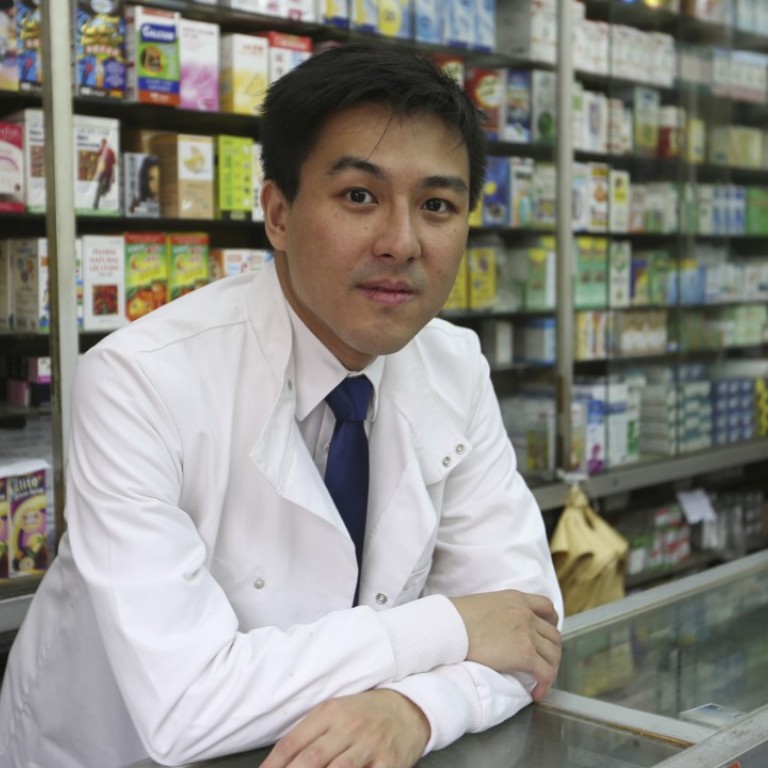
Young Hong Kong pharmacists hope to fill gap in care by helping patients take medicines properly and countering superstition
Many people don’t follow instructions on taking medication because of confusion or cultural beliefs – which can be fatal. A group of health professionals is trying to educate the public about use of prescribed drugs
Karen Lau and Matthew Wong regularly visit elderly people in their homes. The young pharmacists, aged 25 and 28, see patients with chronic illnesses. They help review their medication, and check that they are taking the correct drugs in the right dosages and at the right times.
The pair are also members of Pharmacists Connect, whose main goal is to improve public health by ensuring patients understand how to use medicines prescribed them and the need to follow doctors’ instructions about when and how they should be taken.
The group is made up of young pharmacists who want to shape the future of their profession and collaborate with other health professionals. It is one of three Hong Kong-based societies with similar goals that seek to educate the public and broaden the role of pharmacists within the community.
25pc of patients don’t take prescribed medication, survey finds
Lau, who participates in community outreach programmes with a charitable foundation in Hong Kong, says many patients skip a dose, take more medication than prescribed, take it at the wrong time – or don’t take it at all. The consequences can be harmful, sometimes even fatal.
She recounts one near fatality. “He [the patient] was over 90 years old and had had seven strokes in the past. He was supposed to be on aspirin or another antiplatelet medication but wasn’t taking it, because he was convinced aspirin was making him dizzy.”

Even after his doctor changed the medication to deal with the dizziness, he refused to take it. “Because he had to buy [the medication], he didn’t take it because he believed the purchase was a waste of money. On top of that, his blood pressure was extremely high but he wouldn’t admit that he had hypertension.”
With the patient still feeling dizzy, Lau feared he might have another stroke so she called an ambulance. But the visit to the hospital did not change the man’s mind. After he was admitted and treated at Queen Mary Hospital for a couple of days, the doctor reviewing the case increased the dosage of his antiplatelet medication and sent him home. The man still refuses to follow his medication regimen which, Lau says, is not surprising.
“The patient already has fears and set beliefs [about his medication]. There isn’t enough time in an emergency setting at a hospital to understand what the problems are with each patient, so we see a vicious cycle where patients go in and out of hospital because you can’t solve their problems fundamentally.”

People not taking medication properly is a worldwide problem. According to the World Health Organisation, only about half of patients with chronic diseases follow the instructions given them about how to take medicines; in developing countries more than half don’t follow instructions, particularly patients who are elderly.
A study was published in 2015 in the Journal of Clinical Gerontology & Geriatrics called “Medication adherence in the elderly”. It concluded that elderly people are prone to having multiple diseases or conditions at the same time and must take a number of different medications, making them more likely than younger people not to take medication as ordered. Patients who fail to follow instructions will probably see their health deteriorate, along with their quality of life, and require more frequent visits to their doctor and to hospital.
Some [old people’s] homes hire cheap labour from mainland China who don’t know how to give medication properly
Many studies have looked for factors that affect a patient’s willingness and ability to follow and stick to a medication schedule. The JCGG study, conducted by Singapore’s Duke-NUS Medical School, cites a number of reasons, including mental state, physical health, demographics, past medical history, behaviour, attitude and habits, and knowledge and beliefs.
Wong says cultural and traditional Chinese beliefs about taking medication are prevalent in Hong Kong, and often lead to patients underdosing.
“Chinese people don’t like to talk about their illnesses. If they don’t talk about it then they’re not concerned about it,” he says. “But they also fear the side effects. In the past, every box of drugs in Hong Kong had a red poison icon on it. The board governing medication is called The Pharmacy and Poisons Board of Hong Kong. If every drug is termed a poison, people may think medication is poisonous.”
Hong Kong pharmacists struggle to find jobs amid waning demand and graduate surplus
Another issue in Hong Kong, Wong says, is that drug names are directly translated from English into Chinese. This makes them clumsy and complicated, meaning it is difficult for people to know the names of the drugs they are taking.
“If you ask someone in Hong Kong what a statin is, they probably won’t know. They only know this is the white tablet for lowering cholesterol.”
Misconceptions about prescribed medications can be mitigated, but only if the patient trusts that their practitioner is acting in their best interests. Patients are also more likely to adhere to instructions if they are clearly communicated and if they are involved in the decision.
But the reality is that Hong Kong’s paternalistic health care system is more instructive than inclusive, Lau says, noting that patients are expected to follow their drug regimen without questioning why.

One way to plug gaps in the system is for pharmacists to act as gate keepers in the community, Wong says. He believes the scope of over-the-counter services in pharmacies in Hong Kong can be broadened to include smoking cessation, pregnancy screening and vaccinations, as they have been in such countries as the UK and France. He says that Pharmacists Connect would like to create a model to integrate these broadened services into the community.
The long-term goal is to separate the roles of prescribing drugs and dispensing them. Currently, doctors in Hong Kong can do both, limiting what pharmacists can offer. This is also one of the main reasons why the public knows little about pharmacists and how they can help.
“There’s no regulation in Hong Kong that you need a pharmacist to dispense in a doctor’s clinic,” Wong says. “They can hire a clinic assistant. That’s why our roles are quite limited.”
Discord lands Hong Kong’s health care accreditation plan in disarray
Wong believes pharmacists can intervene at the community level to fill a gap in patient care by ensuring people understand more about their health, how to use medicines prescribed them and the need to follow doctors’ instructions. Such an initiative, he says, has the potential to save the Hospital Authority millions of dollars a year spent on unnecessary admissions to hospital of patients who don’t take medicines as prescribed.
Wong, who works at care homes for the elderly, day care centres and at a pharmacy in Sham Shui Po district, recognises that the elderly are the least literate people in society. Since they need special guidance, he says that staff at care facilities for the elderly also require proper training.
“Some of these homes hire cheap labour from mainland China who don’t know how to give medication properly. If the caregivers don’t know how to administer drugs and deal with potential side effects, then the patient is at [risk of] harm,” he says.
Hong Kong faces medical manpower crisis, government study warns
The use of pharmaceutical pictograms is also being discussed and promoted as a means to tackle the failure of elderly patients to take medications as prescribed. A study by researchers at the City University of Hong Kong conducted last year highlighted that the presentation of information about medicines has been largely ignored or overlooked.
“Pictograms are useful for illiterate individuals and for users not skilled in the local language, for example foreign visitors,” says Dr Annie Ng, lead author of the study. “People who cannot fully understand printed textual medication information will be able to understand the pictorial information.”
Lau says pictograms are used in South Korea. “They print suns and moons and stick them on drug boxes. This can help ethnic minority patients, too.”
Mobile medicine: app eDrug to remind Hong Kong patients not to miss their medication
Those who want to learn more about certain medications can reach Pharmacists Connect through its Facebook page. However, Wong says the best way to find out more about the drugs that you or a loved one are taking is to walk into a pharmacy and start asking questions.
“Pharmacies with an ‘Rx’ symbol imply there’s a pharmacist there,” he says. “Patients can bring their medication prescribed by their doctor or hospital and ask questions in detail, such as how to take them, whether there are any side effects, or if there will be any reactions with food or natural herbal remedies.”
